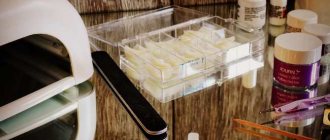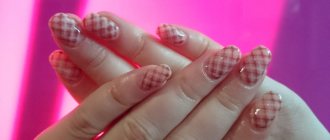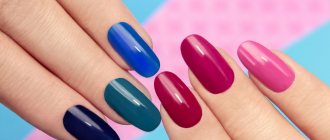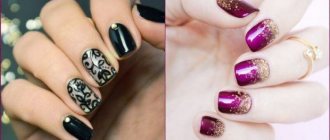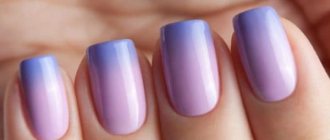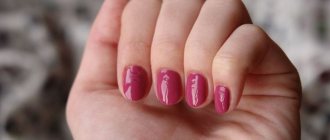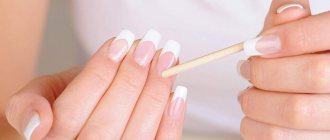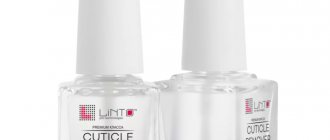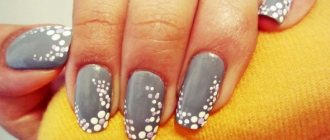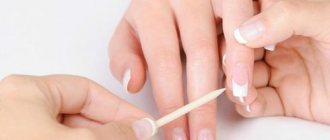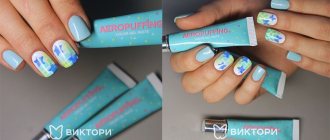Beauty technologies do not cease to develop rapidly, surprising the world with new products every year. Materials for decorating marigolds are becoming more and more convenient and reliable. For example, acrylic (also known as acrygel, polygel, combigel) is a new material that is finding more and more supporters among professional manicurists. You need to know when you hear the word polygel that this is a real salvation for nails.
Manicure with polygel
Nail care in the salon and at home
Before you go to the salon to get your nails beautifully decorated, you should make sure that they are healthy and well-groomed. Many procedures, despite the high level of safety, are still stressful for the nail plates.
Beautiful and strong nails will withstand any manipulation if you supply them with “building materials” in a timely manner, that is, the microelements necessary for growth. You can get them by eating healthy, organic foods, such as dairy products and fruits. Cereals, nuts, and vegetables are no less useful.
You should not constantly apply varnishes and do extensions; sometimes you need to give your nails a rest and treat them. Nourishing oils, baths of herbal decoctions or cosmetic wax are excellent helpers in healing.
To make your nails look attractive, you should devote enough time to a simple home manicure: remove overgrown edges in a timely manner, carefully file off any irregularities, and push back the cuticles. It is important to use disinfected, serviceable tools.
Important! You should not buy varnishes, as well as other materials for nail design, on the cheap. Doubtful compositions, predominantly made in China, are of low quality and can harm the nails.
Advantages of polygel
Acrylic has many advantages:
- It is easy to apply; unlike gel, it does not flow, does not flow into the side rollers, or under the cuticle.
- Holds the arch well, not soft, but at the same time it has the softness of a gel
- Easily filed, unlike acrylic, which took quite a long time to file due to its high rigidity and hardness
- There is no unpleasant odor when laying out the material
- It is worth noting the good durability of the material. The fact is that with proper preparation of the nail plates and applying the base in a thin layer and drying, it practically does not peel off from the nails
- If you decide to remove the material, you will have to do it by cutting, because liquids do not dissolve the polygel, so you will have to be patient and file everything with a file or a ceramic cutter, which will quickly cope with removing the material
- Many masters noted that the free edge on extended nails never peels off, which very often happened with gel, as well as acrylic. The material seems to grow to the nail plate and adheres well to it. After removing the gel polish from the nails, it is quite difficult to see the border between the natural nail and the polygel.
To apply acrylic, you need to dip the brush in a degreaser or a special liquid that is sold complete with acrylic. Many people simply use alcohol instead of liquid. This prevents the material from sticking to the brush and makes laying out easier.
Polygel
Polygel what is it
Polygel nail extension
Poly gel nails is a new technology that uses a composition that combines the properties of gel polish and acrylic. It is particularly reliable and stays on the nails until it is time to make a correction to hide the regrowth. At the same time, the polygel does not damage the nail plate, as happens when using acrylic.
Applying acrylic gel to the nail
The composition differs from gel polish in consistency: it is thick and does not spread when applied.
Acrylatic has a number of other important advantages:
- Does not have a pungent odor. You no longer have to open all the windows wide and suffer from the chemical “amber” that causes headaches. In addition, when working with polygel, you will not have to suffer from the ubiquitous dust. The composition is heavier than acrylic, and its particles settle almost immediately without floating in the air;
- With high strength, the polygel coating looks neat and natural, due to the fact that it is not applied in such thick layers as acrylic;
- The composition does not harden without drying under a UV lamp, which means there is no need to rush with modeling. You can add polygel to your nails until there is enough of it. In this case, unevenness will not appear, and the coating will be uniform;
- The use of a special liquid, a clinser, when working with acrylics makes the application process extremely simple. The composition does not spread, does not harden, lays down evenly and is well distributed with a brush;
- Since streaks are excluded, the skin around the nail will not suffer from the aggressive effects of the composition. This is especially important for girls prone to allergic reactions. Another plus for those with delicate hands is the absence of burning when drying under the lamp;
- After application, the coating almost does not need to be filed, especially since it can be easily removed using a router or file. This flexibility allows you to achieve the ideal shape;
- A thin layer of combigel does not weigh down the nails; high adhesive properties allow you not to worry about the integrity of the coating.
Perhaps the only disadvantage of polygel is the very small selection of colors. The palette of produced materials consists only of shades that are as close as possible to natural ones. If desired, you can apply a layer of bright gel polish on top of the coating, and an impressive manicure is ready.
What brands of acrylic gels are present in imkosmetik?
- Artex, Bluesky, Canni
- Elsa Professional, Grattol, Lunail
- Masura, Monami, Nail Passion
- Nail Republic OXXI
- RIO Profi, TNL Professional, Vogue Nails
Vogue Nails
Polygel from this brand is available in tubes of 10 and 20 ml. The color of the polygel chosen for the photo is transparent pink and has a medium-thick consistency. Squeeze a small drop from the tube and use a spatula to apply the material to the nail plate. To form a short nail, a drop of about 5 mm is enough.
– The material has no odor, it is elastic, plastic and easy to model. The color is close to the natural nail. Based on experience in use, it turned out that it is better to apply the polygel over the base coat, since when applied to the primer, detachments are possible. This is an excellent material for nail repair, extensions, extensions and is well suited for beginners and those who are just trying their hand at nail modeling, advises Ekaterina Volosnikova, nail service master and imkosmetik live broadcast host.
How to use acrylic correctly
Nail correction
If we are talking about nail extensions, then you can work with both top forms and tips. The main thing to do is a regular clean manicure followed by dehydration. An acid-free primer is applied to the prepared nails.
Extensions on top forms with acrylic
How to extend short nails with polygel step by step:
- Forms are applied to the prepared nail plates. If necessary, apply a layer of base coat.
- The brush is moistened in a cleanser so that the bristles are damp, but not dripping.
- You need to take a little acrygel from the tube and put it on the nail using a spatula.
- Next, the composition is distributed over the plate in a thin layer. First, the brush moves towards the cuticle (there is no need to push acrylic under it), then towards the nail folds, and then towards the edge of the form. You need to carefully distribute the polygel, reducing it to almost zero at the edges.
- If there is not enough material, you can add more until you get a thin, neat layer that completely covers the mold.
- The nail is dried in a diode lamp for about 30 seconds. The mold is then removed and the nail is clamped to form an arch.
- A clip for extension is put on the plate, and the nail is dried again for half a minute under the lamp.
- A 140-240 grit file produces sawdust without applying too much pressure.
- The nail is treated with a buff for perfect smoothness.
- Finally, all that remains is to apply top coat or gel polish.
Strengthening nails
Strengthening your nails with Combigel is also not difficult; even a beginner who is starting to learn the basics of nail art can handle it.
How to strengthen nails with acrylic:
- A clean manicure is being performed. If necessary, wipe the marigolds with a dehydrator.
- You don’t need to apply the primer on dry nails; apply it in a very thin layer on wet nails.
- After a minute, it’s time to apply the base and dry the nails in the lamp.
- Moisten the brush in a special liquid, apply the composition to the nail as for extensions.
- Distribute acrygel to strengthen nails, starting from the cuticle and ending with the free edge of the plate. It is necessary to reduce the layer to almost zero. In this case, the excess that collects at the edge of the nail can be removed; if the composition does not stretch well, moisten the brush in the liquid.
- Having collected more clinser on the brush, the polygel layer is leveled, removing unnecessary roughness and unevenness.
- Dry the marigolds under a UV lamp. This will take 2 minutes.
- File off the excess using a 180-240 grit file and buff it.
- If a natural nude shade is suitable, you can apply a transparent top. Provided that the design should be bright, the nails are covered with gel polish.
Applying gel polish to polygel
Note! You can use any topcoat that is convenient to apply, or purchase a special base for polygel.
Nail repair with polygel
The procedure for repairing damaged natural nails is similar to the step-by-step instructions for strengthening them with polygel.
How to repair nails with acrylic gel:
- The first step, as always, is to tidy up your nails and clean them.
- A base is applied to the plates.
- Using a spatula, place an acrygel ball on the nails.
- The brush is slightly moistened with clinser.
- The polygel is distributed over the nail with gentle movements.
- The coating polymerizes under the lamp for 1.5 minutes.
- The shape is filed using a file (maximum 180 grit).
- Finally, a base is applied to the nails.
How to replace liquid for polygel
As a rule, a special construction fluid is used to work with polygel. No less often, a clinser is used for this purpose.
The liquid can be produced by any company; this does not affect compatibility with acrylic. There are times when the constructing composition is not at hand at all. Then you have to look for a replacement for a special liquid among household chemicals.
Liquid for working with acrylics
The simplest solution to the problem is to use regular alcohol. It is capable of softening the composition no worse than the constructive substance. However, professionals do not recommend replacing the original liquid with anything, because using third-party compounds can reduce the level of durability and ductility of acrygel.
In addition, alcohol will greatly dry out the skin around the nail, and with repeated use it will also damage the brush.
Acrygel application technique
Preparatory manipulations boil down to hygienic manicure and cleansing the nail plate of excess moisture and fat. There is no need to apply an acrygel base. It is enough to use a high-quality acid-free primer.
The technology for applying acrylic is as follows:
- glue the form for modeling the nail;
- put a drop of material on the primer using a scraper, pusher or brush (the tool must first be dipped in a degreaser);
- dip the brush in a solution for working with acrylic gel and use it to form the required surface architecture;
- stretching of acrylic is carried out with a brush, gently pressing on the material and leading it in the required direction;
- upon completion of work, dry the coating in a manicure lamp;
- Bring your nails to perfection using a nail file.
Particular attention should be paid to the area adjacent to the cuticle. Insufficient adhesion of the acrylic gel can cause peeling of the coating in the future.
The finishing touch can be applied to any gel polish and decor.
Why doesn't acrylic stick to nails?
What is shellac in manicure
Polygel is a stable coating and problems rarely arise with it. However, errors in its use sometimes lead to peeling.
Partial loss of pigmentation and peeling are possible if the brush is wetted too much with a special liquid. There is no need to saturate the polygel with it, just soften it.
Acrylic does not spread, however, if you dry the finished coating for a short time, it will float. So it’s better to lay out the material, dry it according to the rules, and then admire the neat work.
To prevent air from getting into the material, it is advisable to work with small balls. You should not apply large portions of the composition, believing that this will speed up the work. On the contrary, the more polygel is applied, the more difficult it is to distribute it evenly.
Precautions during operation
Despite the fact that the dust from acrylic gel sawdust is 30% heavier than from gel or acrylic sawdust, the master needs to use a vacuum cleaner to collect it. And also use a protective mask, glasses and a screen when doing polygel nail extensions.
Do not neglect the antiseptic treatment of the natural nail before applying an artificial coating. Acrylic gel is designed for long-term wear. By covering the entire nail plate, it disrupts the natural circulation of air, resulting in an increased risk of the proliferation of pathogenic bacteria.
Individual intolerance to the components of acrylic gel by the client is possible.
How to remove polygel from nails
You can remove the coating using a 160-200 grit file or a manicure cutter. Soaking a persistent composition in any liquids is useless; in addition, it can easily damage your nails.
Acrylic Removal
Even a beginner can figure out how to use poly gel nails. The process of working with the material is simple, and the result will be better than when using other types of coating. Strengthening nails, repairing with polygel and extensions - with this composition everything is possible.
Possibilities of manicure and nail design using acrylic gel
Combining the advantages of other polymers for nail extensions and manicure (varnish, acrylic, gel) in polygel has made it possible to expand the number of services provided in the nail field.
Acrylic gel nail extensions can be done on special forms or tips. This material can be used to strengthen the nail plate, level it, or correct a chip.
Acrylic gel for nail extensions, which specialists can work with even without the use of forms, makes it possible to prosthetize weakened or problematic nails (fungal disease, detachment).
The peeling part of the nail plate is removed, the remaining part is processed, filed and degreased. Then, polygel is applied directly to the skin. The specialist models the desired shape and polymerizes the coating.
Polygel can be applied to protect natural nails from the aggressive effects of household chemical solutions, or for further application of varnish coatings. When creating various designs, the material can be mixed with any color of gel polish to obtain the desired shade.
Strengthening and extending nails with polygel
Acrygel (acrylic, acrylic gel, polygel) - all these are different names for one easy-to-use material that allows you to create short and medium length nail extensions or strengthen the plate without preliminary mixing.
- good flexibility
- lightweight - does not compress the surface of the nail bed,
- does not have a strong odor when applied or dried,
- when filing and removing, dense heavy particles are formed, which quickly settle on the table or in the hood without floating in the air,
- Can be worn alone or under gel polish.
For artists who perform extensions using gel or acrylic materials, polygel will not create inconvenience in their work.
The application process is practically the same and therefore no new courses will be required.
Available packaging formats: tube or jar.
Extensions with tips
Tips are plastic false nails that are glued onto natural nails. They can be transparent, white or colored and are selected individually for each nail.
Tips are ideal for short, narrow or irregularly shaped nails. Tip extensions can also be performed in one, two or three phases.
To make your manicure look truly natural and aesthetically pleasing, you need to choose the right tips.
How to choose suitable tips?
Here are some recommendations for wisely choosing tips:
• The plastic from which the tips are made must be elastic and thin. • The size should correspond as much as possible to the size of natural nails. • For convex and flat nails you need to choose special tips. • For uneven, wavy nails, it is recommended to use a gel adhesive that fills in the unevenness.
You can buy tips using our website with delivery throughout Russia.
Materials for extensions onto tips.
For extensions using this technique you will need the following materials:
Extension with tips. Step-by-step instruction
Stage 1
We prepare the workplace, disinfect hands, tools, materials and surfaces. To make it more convenient to work, you can select tips and immediately arrange them in the order of gluing on each nail. Tips should not exceed 2/3 of the natural nail. The excess must be carefully cut off. You cannot glue tips that are narrower than the nail. It is better to choose the one that is wider and carefully file it to the size of the nail.
Forms or tips – which is better?
Both types and forms have their advantages and disadvantages. First of all, it is worth taking into account individual characteristics. Tips are recommended for those who have short, narrow or irregularly shaped nails. And for nails that grow downwards and bend, shapes are more suitable.
Tips are easier to use and easier to handle at home. But the shapes look thinner and more natural.
In addition, forms have several other advantages:
they do not cover the main part of the plate, so the natural nail has access to oxygen;
extensions on forms strengthen brittle tips on short nails;
with this method of extension, correction can be performed without the need to completely remove the extended layer;
The cured gel polish perfectly complements the natural nail without any obvious transition.
Whatever you choose, in any case, when adding extensions, you need to take care of your nails and make corrections regularly.
How the top forms came to be
We all remember that happy, carefree time when, as small children, we played in the sandbox, filled various molds with wet sand, tipped them over and made Easter cakes. A simple game that is loved by all children.
Even in childhood, it was clear to each of us that sculpting a beautiful and even figure ourselves is much more difficult than simply pouring sand into a ready-made mold and turning it over.
Now imagine how great it would be to transfer this method (with certain changes, of course) to the nail service, using something similar for nail extensions!
Imagine how much easier the process of nail extensions would be if we had a mold prepared in advance for each nail, into which all we had to do was put the construction material (acrylic or gel) and turn it over, as if gluing the material onto a natural nail!
And then, after waiting for the material to dry, remove the mold and get a finished nail, shiny and smooth!
In 2007, the Formula Profi company introduced a new, unique nail extension technology that used the above-mentioned principle. The new technology is called upper forms. It is based on special plastic forms into which the material is laid out.
In order to evaluate the pros and cons of the upper forms technology, we will try to understand how it differs from earlier, preceding technologies.
Advice from experienced manicurists
A novice nail extension artist has plenty of opportunities to learn independently using video tutorials or articles on the Internet. It’s better to take real master classes from professionals. They can share their secrets and valuable information. Here are some of the tips:
All stages of the process, from nail preparation to extension and design, are similar to techniques for working with gels and gel polishes. If you have the skill of building extensions with these materials, mastering the use of acrygel will not be difficult.
